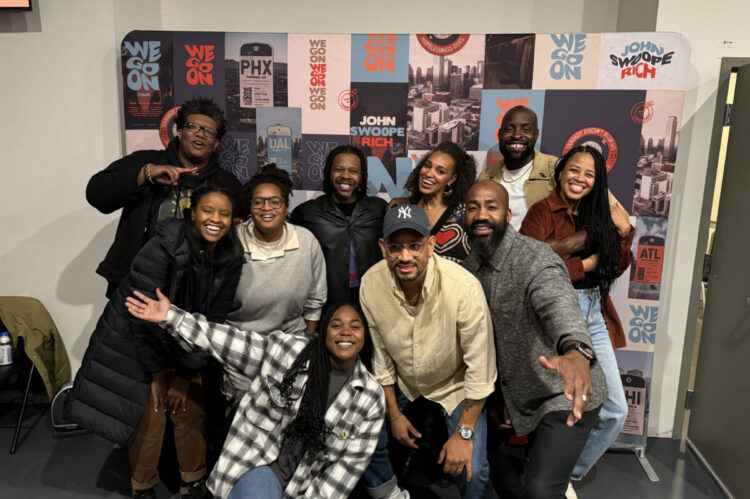“There are years that ask questions and years that answer.”[1] – Zora Neale Hurston
Years that Ask Questions
In my memory, 2015 stands shrouded in a thick fog of forgetfulness. Among this haze, only one pathway remains untouched–a narrow path that’s only about six weeks wide. April 14th to June 17th to be exact. During this time, I lost my brother prematurely, lost my faith completely, planted my third church reluctantly, and began my apprenticeship with sorrow unknowingly.
Unlike traditional apprenticeships, I had no mentor to guide or instruct me through this journey. Reflecting on my pastoral preparation, I realized the glaring gap in my training—I had learned to support others through grief but not how to navigate my own. As the fog of 2015 began to lift, I saw clearly the harm inflicted on those who relied on me for support. Initially, I sought solace in the belief that any harm caused was unintentional, but I now understand that even unintended elbow swings can leave lasting black eyes.
The Problem: No Apprenticeships for Sorrow
Over the past decade of my apprenticeship with sorrow, I’ve come to understand the vital importance of embracing grief as part of this sacred journey. Francis Waller, in his book The Wild Edge of Sorrow emphasizes the need for developing an apprenticeship with sorrow, viewing grief not as something to evade but to lean into. He describes it as the work of becoming an elder, capable of handling grief with skill and transforming sorrow into nourishment for the community.[2]Grief work is soul work.
During the early days of my apprenticeship, I woke each morning hoping to return to a sense of “normalcy.” Yet, I found myself crushed by relentless questions, leading to distress and disappointment in my inability to meet imagined expectations of post-grieving life. As time passed, I realized the futility of seeking a finish line in grief. I’ve learned that grief has no expiration date, and true progress begins when we accept this truth and embrace the journey forward.
The Research: Pulling on Different Threads
My research project on grief found its anchor in the works of Dr. Pauline Boss and Francis Waller. Dr. Boss challenges the notion of closure, emphasizing that grief is enduring and shouldn’t be rushed to an artificial end.[3] Waller builds on this idea, reimagining grief not as a temporary event but as an ongoing conversation that accompanies us throughout life.[4] Rather than viewing grief as a long journey to be navigated, it’s seen as a language to be learned, with the goal being fluency rather than closure.
The challenge lies in immersing ourselves in grief and exercising patience, qualities often lacking in a society that seeks quick escapes from pain. This new paradigm of grief as a language highlights the importance of storytelling in making sense of trauma and reclaiming past narratives. Central to this approach is the concept of “rememory” , originated by Toni Morrison, where individuals take control of their past narratives to shape their present and future experiences.[5] Ultimately, the journey through grief requires sitting with it long enough to find the sweetness on the other side—a lesson best learned through the power of storytelling and rememory. Pulling on the thread of grief and recovering from trauma, led me to some pretty interesting resources on storytelling, language acquisition and trauma processing. I then gathered a group and tried to weave these disparate that ended up becoming a tapesty of a focus-group-style live event across 13 cities with 2600 participants.
The Project: An Immersive Experience In Hope
Taking all of this into consideration, I sought out to create the most pleasant experience anyone would ever have when dealing with the topic of grief. Over the course of 27 days, a group of eight of us visited 13 cities (Los Angeles, Phoenix, Las Vegas, Houston, Austin, Dallas, Chicago, Louisville, Columbus, DC, Philadelphia, NYC and Atlanta) and walked over 2600 people through this evening. We named the evening “We Go On” in an attempt to remind grievers and would-be comforters alike that the goal in grief is not to finish but to move forward.
The We Go On Tour aims to revolutionize storytelling as a means to metabolize grief by creating immersive experiences that allow people to explore grief and hope in a safe and engaging environment. By curating these interactive events, the tour provides participants with an opportunity to observe and live inside others’ grief stories, thus making the process of confronting one’s own grief less intimidating. The ultimate goal is to change the way people engage with their grief, shifting from avoidance to embracing it as a language to be learned.
By immersing people to a point where they do not know what is next, they become captivated by stories told through film, spoken word, comedy, music, and conversation. In the end, attendees leave having gained language and vocabulary to repurpose for themselves.
We Go On: The Audience & Ingredients
The tour targets various audience segments, including those hesitant to confront their grief, professionals in soul care, and program leaders immersed in grief counseling. Through a combination of mystery and immersion, attendees are led through a series of experiences including art, storytelling, comedy, dialogue, and music.
Here are the elements that make up an evening on the We Go On Tour. Below you will find a summary of the most recent iteration of these immersive experiences. We launched a beta version to a total crowd of around 500 people spread across five cities in 2022. What you will find below, in the description and evaluation, is taken from the 13-city version that had a combined audience of around 2600 people.
- ART, ANIMATION & VIDEO – The evening begins with captivating visuals and music to immerse the audience, aiming to activate their senses and facilitate retention, emphasizing the importance of engaging all senses for a truly immersive experience.
- STORYTELLING – Storytelling unfolds through various mediums such as film, monologue, dialogue, music, and comedy, presenting different narratives to help the audience grasp concepts like rememory and narrative love in diverse ways, fostering a comprehensive engagement with grief.
- FILM – The opening film, “It Stays With Us,” directed by Rich Perez, sets the tone by exploring grief’s complexities, emphasizing problem-centric narratives to resonate with the audience’s personal experiences of loss and emotional struggles.
- MONOLOGUE – Monologues, including personal anecdotes and reflections, serve as guides for navigating grief, offering perspectives on its unending nature and suggesting that grief is a language to be learned through patience and immersion, interspersed with audience interaction and reflection.
- COMEDY – Comedy provides a surprising yet effective avenue for exploring grief, offering relief and perspective through humor, easing tension and preparing the audience for deeper, more intense discussions about grief’s enduring impact and potential pathways forward.
- DIALOGUE – Dialogues among diverse speakers, including the organizers, musicians, therapists, and individuals with various experiences of loss, create a sense of community and shared understanding, highlighting the diversity of grief experiences while fostering connections and dispelling feelings of isolation.
- MUSIC – Live music, particularly an extended performance by Grammy Award Winning songwriter & producer Allen Swoope, serves as a powerful conclusion, offering a scripted emotional journey through music and providing a soundtrack for processing grief, complementing the evening’s themes of patience and storytelling.
Each element is carefully designed to engage the senses and facilitate emotional connection, ultimately empowering participants to explore and articulate their own grief narratives. When done successfully, people forget where they are the way you do when you’re immersed in a good memoir or movie. By creating an immersive experience, we foster the patience needed to remind the participants that grief doesn’t have to be avoided, hope is never hurried, and sitting in and staying with your grief is the key to tasting its beauty on the back end.
Reflections
One of the most noticeable shifts through the course of the evening was people’s faces throughout the night. They came not really knowing what to expect and left having experienced a type of communal healing. Soul care workers (i.e. pastors, therapists, etc.) expressed gratitude for the opportunity to focus on their own healing, while the people who participated from the stage each night found therapeutic value in rehearsing their stories. The success of the tour lies in its ability to provide a sense of community and belonging, as well as a platform for sharing testimonies of hope amidst grief.
The hoped-for change is made possible by people’s desire for community and their innate longing to share testimonies of change. By offering a space where it’s okay not to be okay and providing examples of resilience and hope, the tour aims to equip individuals with the language and support needed to navigate their grief journeys. Ultimately, the tour seeks to challenge the notion that grief is something to be overcome quickly, emphasizing instead the importance of patience, immersion, and community in the healing process.
Fluency Felt in New Stories
”To survive trauma, one must tell a story about it,” Natasha Trethewey [6]
Natasha Trethewey uses her memoir Memorial Drive to recount her journey to healing from her mother’s murder. This narrative, though harrowing, ends with a serendipitous encounter that, in an instant, ends up reshaping her perception of her trauma. Her loss undergoes a transformation through the act of rememory, a process years in the making, yet instrumental in offering to heal others who hear about her trauma, emphasizing the virtue of patience as a pathway to progress.
The aim of this project was to reenvision spaces fostering emotional healing, integrating arts and creativity into the therapeutic landscape. While not a panacea, this particular application is successful at alleviating the initial roadblocks hindering healing. Memoirs, fiction, comedy, music, or even scholarly projects focused on singular days can serve as channels (very pleasant ones at that) for processing grief.
People’s behavior will never rise above their vision, so our goal was to give people a vision of what it looks like to smile in the midst of their trauma. A smile that’s not dismissive of the events but a smile that comes as a result of realizing that the grief is presently being metabolized into something beautiful.
Years that Give Answers
Reflecting on the aftermath of personal loss, I stumbled upon a different April narrative than the one mentioned in the introduction. Some may call it a rememory. 2017 doesn’t have nearly as much fog as 2015.
I remember April 14th, 2017, very clearly. Holding my premature daughter in a NICU in Columbus, Georgia, I found myself drinking in an interesting cocktail of emotions. Despite the discomforts of cramped rooms with too many medical machines to count, her first smile through the incubator’s glass remains etched in memory.
That Good Friday in April, however, bore an additional weight—it marked both the anniversary of Jesus’ crucifixion and my brother’s final breaths. Holding my daughter, grief and hope intersected as the doctor tapped me on the shoulder to alert me to a pivotal moment: after 8 days of having a breathing tube in her nose, today would be the day she took her first unassisted breaths.
In that instance, grief and hope’s fingers interlocked like middle school love birds–reshaping my understanding of faith and circumstance.
Over seven years, I’ve recounted this tale, each retelling reinforcing the virtue of patience in allowing God to script individual narratives. Amidst tragedy, hopelessness proves the true adversary, reminding us that God’s grace extends equitably, nurturing resilience in the face of adversity.
[1] Zora Neale Hurston, Their Eyes Were Watching God (New York: Perennial Classics, 1998), 21.
[2] Francis Weller, The Wild Edge of Sorrow: Rituals of Renewal and the Sacred Work of Grief (Berkeley, CA, 2015), 7.
[3] Pauline Boss, The Myth of Closure: Ambiguous Loss in a Time of Pandemic and Change (New York: WW Norton, 2022), xvii
[4] Francis Weller, The Wild Edge of Sorrow: Rituals of Renewal and the Sacred Work of Grief (Berkeley, CA, 2015), 4.
[5] Caroline Rody, “Toni Morrison’s Beloved: History, ‘Rememory,’ and a ‘Clamor for a Kiss.’” American Literary History 7, no.1 (1995): 102-103, https://doi.org/10.1093/alh/7.1.92.
[6] Natasha Trethewey, Memorial Drive: A Daughter’s Memoir (New York: Harper Collins, 2020), 208.

